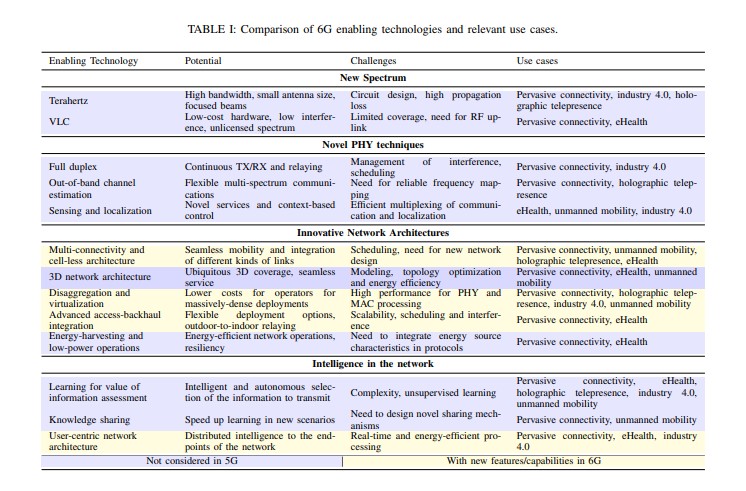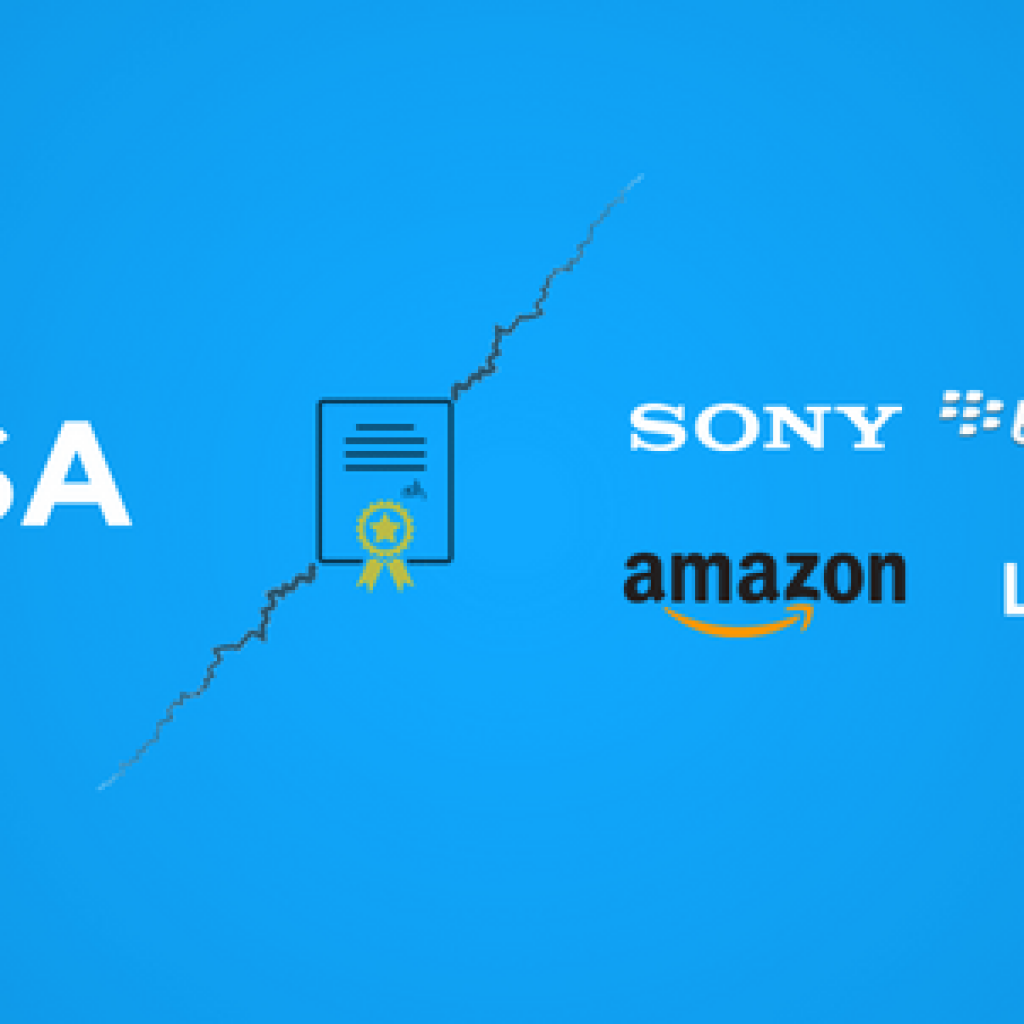The adoption of 5G will propel the whole range of disruptive technologies, including AI, IoT, and robotics. With 5G bringing so much possibility in almost every domain, one must think – what’s next? 6G?
Working on the 5G SEP analysis with my team got me thinking, the world has witnessed the evolution from 3G -> 4G -> 5G. Hence, 6G is the next obvious idea, and just like 5G, 6G too might soon become the buzzword for telecom giants.
Talking about 5G SEP, we performed a detailed analysis on 12000+ 5G declared patents to find the exact number of the core essential 5G patents. From the analysis, we found the number of core 5G SEPs and the top companies holding those core 5G SEPs. You can get our exclusive 5G SEP Report by filling the form below.

So, where is 6G now?
There are few who work in the present and there are few who invent the future. Many companies have already started working on 6G and trying to lay down how the next generation of communication is going to work. However, let’s start with first understanding where we are right now.
How Much has 6G Network Evolved?
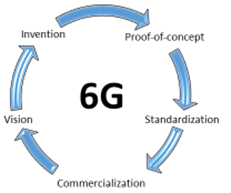
The wheel of evolution for any generation of telecom technology looks something like this:
The wheel starts with a vision of certain scenarios or applications catering to problems/needs and their requirements. Then companies start doing research to find and patent different inventions for fulfilling those requirements and make models to test it.
Afterward (or perhaps parallelly), the standardization efforts start where the industry leaders collaborate to define standards that the devices must comply with in order to meet the requirements set in the vision stage and interoperate with the devices of each other.
In the wheel of evolution, 6G is in a pretty early stage and no technology has been invented yet to cater to the requirements set for the 6G standards. So, this corresponds to the ‘Vision Stage’ where a problem or need is identified and all the requirements are established. The next stage would be the ‘Invention Stage’.
To paraphrase, 6G right now is at the vision stage and moving towards the invention stage.
However, while many operators are yet to introduce 5G networks, developers have already started active research in 6G.
In fact, the University of Oulu of Finland organized the 6g Flagship event, which is the first 6G Wireless Summit with almost 300 participants from 29 countries, including major infrastructure manufacturers, operators, regulators as well as academia.
The summit resulted in the first-ever white paper on 6G published in September 2019 by the University of Oulu.
If you are interested in understanding 6G implementation, here are some of the highlights discussed in the whitepaper –
- Artificial intelligence and machine learning will play a major role both in the link and system-level solutions of 6G wireless networks.
- Extended-spectrum towards THz will enable merging communications and new applications, such as 3D imaging and sensing.
- New access methods will be needed for truly massive machine-type communications. Modulation and duplexing schemes beyond Quadrature Amplitude Modulation (QAM) and Orthogonal Frequency Division Multiplexing (OFDM) must be developed and possibly it is time to start looking at analog types of modulation at THz frequencies.
- It predicts a shift in user devices from smartphones toward wearable devices (particularly lightweight glasses) having virtual, augmented, or mixed reality capability. The necessary supporting technologies include:
- imaging devices such as light field, panoramic, depth-sensing, and high-speed cameras;
- biosensors for monitoring health conditions such as the heart rate, blood pressure, and neural activity;
- specialized processors for computer graphics, computer vision, sensor fusion, machine learning, and AI, either in the device or in the surrounding network infrastructure;
- The concept of semantic communications (using the meaning of the messages for making the connectivity and networking more efficient), is an important emerging area of research which is closely connected to semantic AI.
- Autonomous vehicles are made possible by advances in wireless networks and in distributed AI and sensing. Each vehicle in a future network will be equipped with many sensors, including cameras, laser scanners, possibly THz arrays for 3D imaging, odometry, and inertial measurement units.
- It is believed that to make 6G acceptable to society, the protection of private information will be a key enabler to realize its full potential. The secrecy is ensured through quantum mechanics instead of complex computation. Furthermore, authentication by a physical layer signature, such as RF fingerprinting, and some other technologies, such as randomization of MIMO transmission coefficients, coding, etc., could potentially be used in 6G.
- In addition to the terrestrial networks, infrastructures based on satellite and unmanned aerial vehicles (or similar aerial platforms) will be needed to support the coverage and capacity requirements.
5G vs 6G
Knowing about the advances 5G brought in you must be wondering what 6G and B5G (beyond 5G) networks will bring to the table? Well, here you go:
Comparison of some of the Key Performance Indicators
| KPI | 5G (consistent with 3gpp standards) | 6G (consistent with published white papers) |
| Peak data rate (DL) | 20 Gbps | 100 Gbps – 1 Tbps |
| Radio Latency (User plane) | Less than 1 ms |
0.1 ms |
| Density | 1 device per m2 | 10 devices per m2 |
|
Traffic Increase | 1000 times | 10,000 times |
Technology-wise comparison
| Technology | 5G (consistent with 3gpp standards) | 6G (consistent with published white papers) |
| Terahertz spectrum and RF Devices Improvements | No | Yes |
| Satellite (non-terrestrial) communication techniques | Yes
(Discussion seem limited to change requests only as of now and are not included in standards yet) (Example – R3-185310) | Yes
(It also seems to be a major technical advancement discussed for 6G) |
| Artificial Intelligence/Machine learning | Probable
(Discussion seem to be at a nascent level) (Example – RP-182105) | Yes
(It seems to be a major technical advancement discussed for 6G) |
| Semantic communication
(using the meaning of the messages for making the connectivity and networking more efficient) | No | Yes |
| Analog modulation techniques (as QAM and OFDM might not work the best at THz frequencies) | No | Yes |
| Single-frequency full-duplex Systems
(the transmitter and receiver will operate on the same frequency at the same time) | No | Yes |
What will 6G look like?
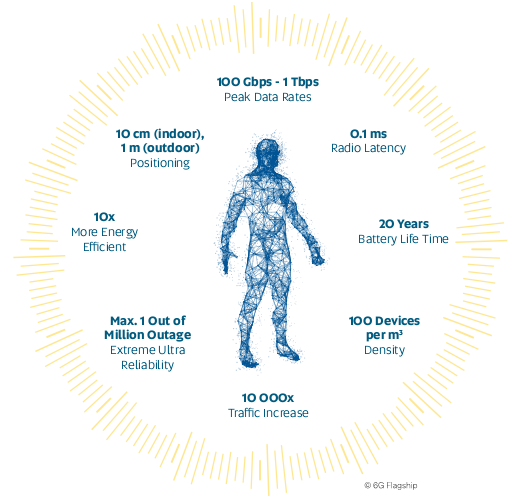
These are the key performance indicators for 6G and B5G networks. Simply put, 6G is widely believed to be smarter, faster, and more efficient than 5G.
6G research includes the challenge of transmitting up to 1 Tbps per user. It is set to be as much as 100 times faster than 5G. Where 5G speeds are expected to allow users to download the content of an entire DVD in split seconds think what 6G can bring?
Another fundamental difference of 6G technology will be the use of millimeter waves, which is expected to lead to possibly noteworthy breakthroughs in wireless sensing technology.
Latency too is expected to improve on a huge scale, with air latency targeted to be around 100 μs, end-to-end (E2E) latency of around 1 ms which would result in user experience latency of less than 10 ms.
6G promises to be a better and faster version of 5G and its predecessors. It makes one wonder, what are companies doing towards developing the 6G standard?
Which companies are working on 6G?
Competition has started between telecom companies to get their share in 6G and companies have already started publishing whitepapers on the 6G technology ( listed below ).
1. NTT Docomo White paper on 6G
After the above discussed first white paper got published in September 2019, NTT Docomo published a white paper in January 2020. An interesting view presented in this paper for new wireless transmission technologies that may be used in 6G is that instead of using OFDM techniques, faster-than-Nyquist (FTN) signaling — which compresses and transmits signals non-orthogonally using a sampling rate faster than the frequency bandwidth in the time domain — will be used. It also proposes virtual massive (VM)-MIMO technology to cater to the antenna gain requirements.
2. Rohde & Schwarz white paper
Rohde & Schwarz published a paper in March 2020. The mentioned concepts and insights in the paper are quite similar to NTT Docomo’s paper.
3. The Finnish 6G Flagship
They published 11 new 6G White papers in June 2020, so that makes the total count of papers from Flagship to be 12.
Then as the latest development came Samsung’s white paper in July 2020.
4. Samsung in 6G
On the technical front, Samsung’s research paper published in July 2020 seems a bit ahead of the University of Oulu whitepaper. Here are some new technologies that I found worth highlighting:
- More clarity is provided on the Novel Antenna Technologies needed for THz communication.
In this, technical advancements on two vanguards have been discussed:
- Metamaterial based Antenna and RF Front-End –
A metamaterial is usually constructed by arranging multiple tunable elements (PIN diodes, Varactor diodes, etc.) in repeating patterns, at scales that are smaller than the wavelengths.
Although this concept isn’t new and we found research dating back to 2002 on this technique [Source 1 (2002), Source 2 (2012), Source 3 – related to THz communication (2015)], but Samsung’s paper specifically discusses three outstanding approaches for utilizing metamaterials.
-
- A metasurface lens has the potential to help sharpen a beam shape.
- Metamaterial antenna acts as a resonant antenna to radiate directive beams by itself.
- Reconfigurable intelligent surface (RIS) can be used to provide a propagation path where no LoS link exists
- Orbital Angular Momentum –
Through OAM, high-order spatial multiplexing can be achieved in an environment where it is impossible with conventional MIMO technologies, i.e., LoS channels. However, it seems that its practical implementation isn’t realizable at present.
- Spectrum Sharing: A challenge faced in implementing dynamic spectrum sharing is the collision of spectrum usage. The paper proposes to use AI to predict usage from other entities and thus help reduce collisions with minimum overhead.
- Using Split Computing, that is devices can offload heavy computations tasks to other computations resources available in the network.
Okay, so we got to know about the whitepapers. But are you also wondering about the other research activities in the domain?
Who is developing the 6G technology?
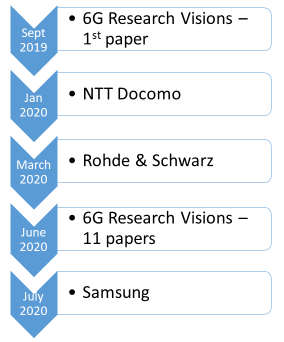
Research activities have been kickstarted by some telecom companies such as Samsung, Ericsson, and Nokia since FCC opened a 6G spectrum for research in March 2019. There are many others who are working on it but have not come out openly in public.
Here are a few companies that are actively researching in 6G and openly sharing with everyone about their activities.
1. Samsung
Samsung kicked off 6G research in June 2019. In July 2020, Samsung released a white paper that laid out the company’s vision for the 6G technology.
Besides, in-house research, Samsung is having partnerships with multiple companies.
In Jul 2021, The University of Texas launched a 6G research center with the support of major wireless industry players, including Samsung.
In Feb 2022, Samsung partnered with Keysight to advance the research and development of 6G technology.
The main focus of this partnership will be to accelerate the development of AI-enabled air interfaces that leverage massive Multiple-Input Multiple-Output (MIMO) antenna technology.
In May 2022, Samsung released a white paper that lays out the Company’s vision for securing global frequency bands for 6G. The paper, titled “6G Spectrum: Expanding the Frontier,”1 discusses ways to obtain the spectrum needed to achieve the company’s 6G vision introduced in a white paper released earlier in July 2020.
2. Ericsson
Like 5G, Ericsson is aggressively researching 6G as the company is one of few companies that manufactures next-gen network infrastructure.
Ericsson like Samsung is part of many partnerships and initiatives.
The company also releases articles and research papers on network trends.
In 2021, Ericsson’s CTO, ERIK EKUDDEN, issued technology trends where he talks about the trends and vision for the future network platform and what is driving the changes.
In Jun 2021, Ericsson released a post on five key technology building blocks that will drive mobile network evolution towards 2030 and beyond. The post also provides future use cases of the 6G technology.
Ericsson is also a lead member of the Europe Hexa-X initiative.
3. Nokia
Nokia is another European company that is leading in 5G and that lead also helps the company in the race for 6G networks.
Like Ericsson, Nokia is also aggressive towards 6G networks and making news every now on for 6G research.
Besides multiple partnerships, perhaps the biggest achievement of Nokia is that the company is the project leader of Europe’s 6G flagship initiative, Hexa-X.
The Hexa-X vision is to connect human, physical, and digital worlds with a fabric of 6G technology enablers
Hexa-X is the first official research initiative across the industry ecosystem to accelerate and foster 6G research and drive European leadership in the 6G era.
Further, its CEO is always in news providing insights into the company’s ongoing research and predicting the future of 6G networks.
In May 2022, Nokia’s CEO predicted that the 6G will be available in the market by 2030 and the smartphone is going to be obsolete.
“Right now, we’re all building 5G networks, as we know, but by the time quantum computing is maturing for commercial applications, we’re going to be talking about 6G,” Pekka Lundmark was quoted as saying by media reports. “By then, [2030], definitely the smartphone as we know it today will not anymore be the most common interface.”
4. NTT Docomo
As mentioned above, NTT has also published a white paper on 6G which clearly indicates the company’s intentions to be ahead in the race.
With a target to deploy commercial 6G technology, NTT DOCOMO will conduct multiple tech trials with Fujitsu, NEC, and Nokia. The focus of these trials will be the development of new mobile communications technologies suitable for use with high-frequency spectrum in the millimeter and sub-terahertz bands (above 6 GHz), as well as in the sub-6 GHz spectrum bands being used for 5G services. It will also include work on artificial intelligence (AI)-enabled wireless transmission methods.
5. Huawei
This CNET article suggests that the Chinese company is researching 6G at its R&D center in Ottawa, Canada.
6. LG
In January 2019, Samsung’s native rival LG also opened a 6G research center, in collaboration with the Korea Advanced Institute of Science and Technology (KAIST).
At the IEEE International Conference on Communications (ICC) 2022, LG Electronics showcased its 6G communications technologies, including Full-Duplex Radio transmission and reception tech that maximizes frequency efficiency, and a power amplifier device, jointly developed with the Fraunhofer Heinrich Hertz Institute (HHI), for the wireless transmission and reception of 6G THz data.
7. ZTE
On May 17, 2020, Chinese telecom equipment manufacturer ZTE agreed with major carrier China Unicom to jointly review 6G prospects and technology trends, and carry out research on key technology and standard cooperation. (Source).
Which Universities are working on 6G?
With all the industry giants wanting to gain a lion’s share in the 6G market, universities also seem to be at the forefront of innovation in this direction. Along with the University of Oulu, a lot of papers and even patents have been filed by some universities.
Below listed are some of the universities and their respective activities in the domain:
1. Beijing University of Posts and Telecommunications
We found two patents by the university, which are specifically related to Beyond5thGeneration (or, B5G, as they have called it) and 6G technologies. These patents are CN110392350A and CN110430550A, claiming priority from August 2019.
Other than these patents, there is also a research paper from the same university filed in March 2020 – Channel measurements and models for 6G: current status and future outlook.
2. University of Padova, Italy
The University of Padova published a whitepaper which is an effort in understanding the main challenges, potential, and use cases of 6G technologies that the university’s researchers believe will characterize 6G networks – Towards 6G Networks: Use Cases and Technologies.
The table below enlists the relevant use cases discussed in the paper.
They have concluded that these technologies, however, are not market-ready. This appears to be a unique opportunity for the wireless research community to foster innovations that will enable unanticipated digital use cases for the world of 2030 and beyond.
3. University of Aveiro
This research paper from March 2019 also paves a way for the need to look into 6G – Why 6G?.
The paper presents the potential driving forces behind the development of 6G. It also mentions that AI and ML applications would find a prolific presence in the 6G technology. And it introduces new dimensions that are expected to find places in the 6G ambit, such as – ‘quantum communication’ and ‘satellite integration’.
Universities are probably being ignored or not given too much of the limelight at the time, but they seem to be playing a pilot role in laying a roadmap for 6G, deciding how 6G infrastructure/technologies are going to be.
4. University of Texas
In Jul 2021, The University of Texas at Austin launched a 6G research center with the support of major wireless industry players, including Samsung, AT&T, and Qualcomm. Nvidia and InterDigital also are among the five founding affiliates. Advanced sensing, location, machine learning capabilities, and the use of the terahertz spectrum are a few of the key aspects the research center is focused on for 6G.
Wanna stay updated on what happens next in 6G? Subscribe to us and stay ahead of the curve.
Authored by: Ankush Sharma, Team Lead, and Krishna Aswani, Manager, Prior Art Search Team.
About Author: Ankush is a Team Lead with GreyB and has worked in technologies ranging from 3G to 5G. He takes a keen interest in monitoring the current state of research and upcoming tech in the telecom domain.


